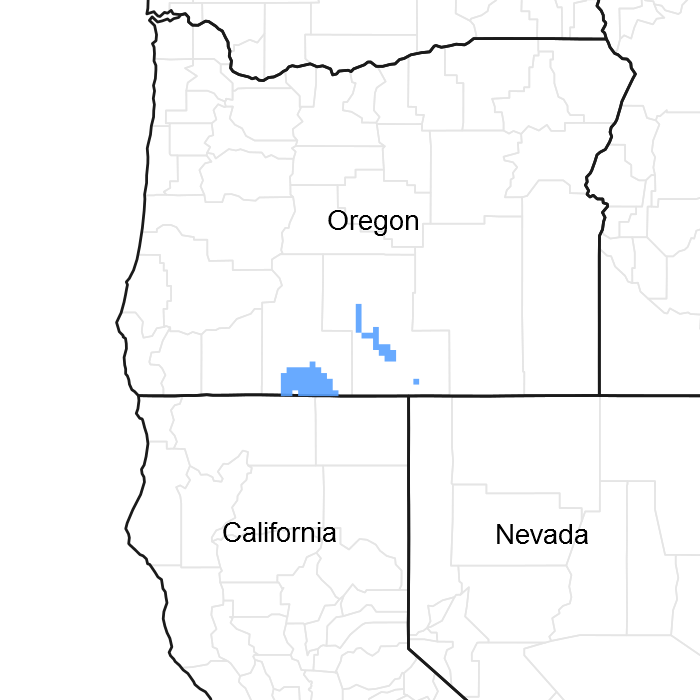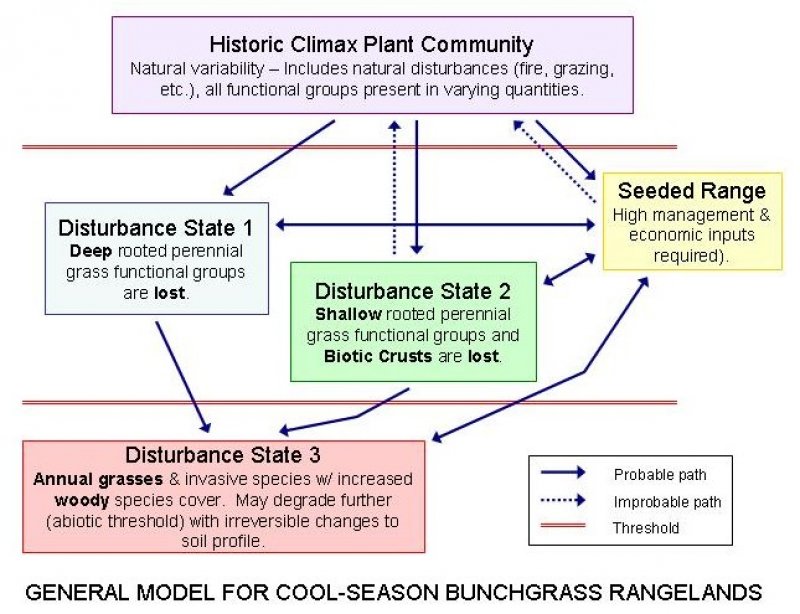
Natural Resources
Conservation Service
Ecological site R021XY206OR
DEEP LOAMY 10-14 PZ
Accessed: 12/21/2025
General information
Provisional. A provisional ecological site description has undergone quality control and quality assurance review. It contains a working state and transition model and enough information to identify the ecological site.

Figure 1. Mapped extent
Areas shown in blue indicate the maximum mapped extent of this ecological site. Other ecological sites likely occur within the highlighted areas. It is also possible for this ecological site to occur outside of highlighted areas if detailed soil survey has not been completed or recently updated.
Associated sites
| R021XY204OR |
SHALLOW STONY 10-20 PZ |
|---|---|
| R021XY300OR |
SOUTH SLOPES 10-14 PZ |
| R021XY302OR |
NORTH SLOPE 10-14 PZ |
Similar sites
| R021XY200OR |
LOAMY 10-14 PZ Thinner surface |
|---|---|
| R021XY210OR |
LOAMY 14-18 PZ Thinner surface |
Table 1. Dominant plant species
| Tree |
Not specified |
|---|---|
| Shrub |
Not specified |
| Herbaceous |
Not specified |
Physiographic features
This site occurs on terraces and alluvial fans. Slopes range from 0 to 35 percent, but typically are less than 15 percent.
Table 2. Representative physiographic features
| Landforms |
(1)
Terrace
(2) Alluvial fan |
|---|---|
| Elevation | 4,100 – 5,000 ft |
| Slope | 35% |
| Aspect | Aspect is not a significant factor |
Climatic features
The annual precipitation ranges from 10 to 14 inches, most of which occurs in the form of snow during the months of October through April. The soil temperature regime is mesic with the mean annual air temperature of about 47 degrees F. Temperature extremes range from 100 to -30 degrees F. The frost free period ranges from 70 to 120 days. The optimum period for plant growth is from mid-April to late June.
Table 3. Representative climatic features
| Frost-free period (average) | 120 days |
|---|---|
| Freeze-free period (average) | 0 days |
| Precipitation total (average) | 14 in |
Influencing water features
Soil features
The soils of this site are deep and well drained. Typically the surface layer is loam and the subsoil is loam or clay loam. Organic matter content is over 1% in the upper 20 inches. Permeability is moderate to moderately slow. The available water holding capacity is 8 to 12 inches. Runoff is slow to medium. Erosion hazard by water is slight to moderate.
Table 4. Representative soil features
| Surface texture |
(1) Loam |
|---|---|
| Family particle size |
(1) Loamy |
| Drainage class | Well drained |
| Permeability class | Moderately slow to moderate |
| Soil depth | 60 in |
| Available water capacity (0-40in) |
8 – 12 in |
Ecological dynamics
If the condition of the site deteriorates as a result of overgrazing, big sagebrush, horseshoe, and rabbitbrush will become dominant on the site. Bitterbrush, bluebunch wheatgrass and Idaho fescue will decrease. Sandberg bluegrass, squirreltail and unpalatable forbs will increase in the understory. Cheatgrass and annual forbs will invade the site. Juniper may invade from adjoining sites.
This site is typically dominated by bluebunch wheatgrass. Basin wildrye and Idaho fescue are common. On steep slopes that tend toward a northerly exposure, Idaho fescue may increase.
State and transition model

More interactive model formats are also available.
View Interactive Models
More interactive model formats are also available.
View Interactive Models
Click on state and transition labels to scroll to the respective text
Ecosystem states
State 1 submodel, plant communities
State 1
HCPC, PSSP6-LECI4/PUTR2-ARTRT
Community 1.1
HCPC, PSSP6-LECI4/PUTR2-ARTRT
The potential native plant community is dominated by bluebunch wheatgrass. Basin wildrye is prominent. Idaho fescue and Canby bluegrass are common. Antelope bitterbrush dominates the aspect and basin big sagebrush occurs. Vegetative composition of the community is approximately 70% grasses, 10% forbs, and 20% shrubs.
Figure 2. Annual production by plant type (representative values) or group (midpoint values)
Table 5. Annual production by plant type
| Plant type | Low (lb/acre) |
Representative value (lb/acre) |
High (lb/acre) |
|---|---|---|---|
| Grass/Grasslike | 780 | 1028 | 1275 |
| Shrub/Vine | 195 | 285 | 375 |
| Forb | 90 | 158 | 225 |
| Total | 1065 | 1471 | 1875 |
Figure 3. Plant community growth curve (percent production by month). OR5511, D21 Low Elev., NA, Good Condition. RPC Growth Curve.
| Jan | Feb | Mar | Apr | May | Jun | Jul | Aug | Sep | Oct | Nov | Dec |
|---|---|---|---|---|---|---|---|---|---|---|---|
| J | F | M | A | M | J | J | A | S | O | N | D |
| 0 | 0 | 15 | 30 | 50 | 5 | 0 | 0 | 0 | 0 | 0 | 0 |
Additional community tables
Table 6. Community 1.1 plant community composition
| Group | Common name | Symbol | Scientific name | Annual production (lb/acre) | Foliar cover (%) | |
|---|---|---|---|---|---|---|
|
Grass/Grasslike
|
||||||
| 1 | Dominant deep rooted perennial grasses | 600–900 | ||||
| bluebunch wheatgrass | PSSP6 | Pseudoroegneria spicata | 375–525 | – | ||
| basin wildrye | LECI4 | Leymus cinereus | 225–375 | – | ||
| 2 | Sub-dominant deep rooted perennial grasses | 75–150 | ||||
| Idaho fescue | FEID | Festuca idahoensis | 75–150 | – | ||
| 4 | Sub-dominant shallow rooted perennial grasses | 75–150 | ||||
| Sandberg bluegrass | POSE | Poa secunda | 75–150 | – | ||
| 5 | Other perennial grasses | 30–75 | ||||
| Thurber's needlegrass | ACTH7 | Achnatherum thurberianum | 0–5 | – | ||
| sedge | CAREX | Carex | 0–5 | – | ||
| squirreltail | ELEL5 | Elymus elymoides | 0–5 | – | ||
| prairie Junegrass | KOMA | Koeleria macrantha | 0–5 | – | ||
|
Forb
|
||||||
| 7 | Dominant perennial forbs | 75–150 | ||||
| common yarrow | ACMI2 | Achillea millefolium | 15–30 | – | ||
| agoseris | AGOSE | Agoseris | 15–30 | – | ||
| arrowleaf balsamroot | BASA3 | Balsamorhiza sagittata | 15–30 | – | ||
| fewflower pea | LAPA5 | Lathyrus pauciflorus | 15–30 | – | ||
| lupine | LUPIN | Lupinus | 15–30 | – | ||
| 9 | Other perennial forbs | 15–75 | ||||
| mariposa lily | CALOC | Calochortus | 0–5 | – | ||
| Indian paintbrush | CASTI2 | Castilleja | 0–5 | – | ||
| tapertip hawksbeard | CRAC2 | Crepis acuminata | 0–5 | – | ||
| Scouler's woollyweed | HISC2 | Hieracium scouleri | 0–5 | – | ||
| nineleaf biscuitroot | LOTR2 | Lomatium triternatum | 0–5 | – | ||
|
Shrub/Vine
|
||||||
| 12 | Sub-dominant evergreen shrubs | 30–75 | ||||
| basin big sagebrush | ARTRT | Artemisia tridentata ssp. tridentata | 30–75 | – | ||
| 13 | Dominant deciduous (or 1/2 shrubs) shrubs | 150–225 | ||||
| antelope bitterbrush | PUTR2 | Purshia tridentata | 150–225 | – | ||
| 15 | Other shrubs | 15–75 | ||||
| Saskatoon serviceberry | AMAL2 | Amelanchier alnifolia | 0–5 | – | ||
| green rabbitbrush | ERTE18 | Ericameria teretifolia | 0–5 | – | ||
| Klamath plum | PRSU2 | Prunus subcordata | 0–5 | – | ||
| wax currant | RICE | Ribes cereum | 0–5 | – | ||
| littleleaf horsebrush | TEGL | Tetradymia glabrata | 0–5 | – | ||
Interpretations
Animal community
This site offers forage for pronghorn antelope and mule deer and limited cover for various bird species.
Hydrological functions
The soils are in hydrologic group B.
Other products
This site is suited to livestock grazing during spring and fall under a planned grazing system.
Supporting information
Contributors
Barrett, Carlson
E Ersch (OSU)
K.Kennedy
Rangeland health reference sheet
Interpreting Indicators of Rangeland Health is a qualitative assessment protocol used to determine ecosystem condition based on benchmark characteristics described in the Reference Sheet. A suite of 17 (or more) indicators are typically considered in an assessment. The ecological site(s) representative of an assessment location must be known prior to applying the protocol and must be verified based on soils and climate. Current plant community cannot be used to identify the ecological site.
| Author(s)/participant(s) | Jeff Repp |
|---|---|
| Contact for lead author | Oregon NRCS State Rangeland Management Specialist |
| Date | 08/21/2012 |
| Approved by | Bob Gillaspy |
| Approval date | |
| Composition (Indicators 10 and 12) based on | Annual Production |
Indicators
-
Number and extent of rills:
None, slight to moderate sheet & rill erosion hazard -
Presence of water flow patterns:
None -
Number and height of erosional pedestals or terracettes:
None -
Bare ground from Ecological Site Description or other studies (rock, litter, lichen, moss, plant canopy are not bare ground):
5-10% -
Number of gullies and erosion associated with gullies:
None -
Extent of wind scoured, blowouts and/or depositional areas:
None, slight wind erosion hazard -
Amount of litter movement (describe size and distance expected to travel):
Fine - limited movement -
Soil surface (top few mm) resistance to erosion (stability values are averages - most sites will show a range of values):
Slightly to moderately resistant to erosion: aggregate stability = 4-5 -
Soil surface structure and SOM content (include type of structure and A-horizon color and thickness):
Deep, well drained loams, fine sandy loams, and silt loams: Moderate to high OM (3-5%) -
Effect of community phase composition (relative proportion of different functional groups) and spatial distribution on infiltration and runoff:
Significant ground cover (60-70%) limits rainfall impact and overland flow (slightly higher hazard on steeper slopes (to 35%)) -
Presence and thickness of compaction layer (usually none; describe soil profile features which may be mistaken for compaction on this site):
None -
Functional/Structural Groups (list in order of descending dominance by above-ground annual-production or live foliar cover using symbols: >>, >, = to indicate much greater than, greater than, and equal to):
Dominant:
Bluebunch wheatgrass > Basin wildrye > Antelope bitterbrush > other grasses > forbs > Basin big sagebrush > other shrubsSub-dominant:
Other:
Additional:
-
Amount of plant mortality and decadence (include which functional groups are expected to show mortality or decadence):
Normal decadence and mortality expected -
Average percent litter cover (%) and depth ( in):
-
Expected annual annual-production (this is TOTAL above-ground annual-production, not just forage annual-production):
Favorable: 2000, Normal: 1500, Unfavorable: 900 lbs/acre/year at high RSI (HCPC) -
Potential invasive (including noxious) species (native and non-native). List species which BOTH characterize degraded states and have the potential to become a dominant or co-dominant species on the ecological site if their future establishment and growth is not actively controlled by management interventions. Species that become dominant for only one to several years (e.g., short-term response to drought or wildfire) are not invasive plants. Note that unlike other indicators, we are describing what is NOT expected in the reference state for the ecological site:
Perennial brush species will increase with deterioration of plant community. Western Juniper readily invades the site. Cheatgrass and Medusahead invade sites that have lost dep rooted perennial grass functional groups. -
Perennial plant reproductive capability:
All species should be capable of reproducing annually
Print Options
Sections
Font
Other
The Ecosystem Dynamics Interpretive Tool is an information system framework developed by the USDA-ARS Jornada Experimental Range, USDA Natural Resources Conservation Service, and New Mexico State University.
Click on box and path labels to scroll to the respective text.